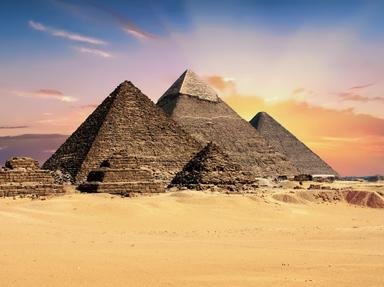Quiz Answer Key and Fun Facts
1. Which ancient wonder did Sostrates of Knidos design?
2. This ancient wonder was located off the southwestern tip of Asia Minor where the Aegean Sea meets the Mediterranean. It was created in 311 B.C., and was designed by Chares of Lindos. What is the name of this wonder?
3. Scopas of Pharos designed this magnificent ancient wonder. According to the ancient texts, this wonder took 120 years to build. What is the name of this ancient wonder?
4. In 353 B.C., upon the death of her husband, Queen Artemisia had ordered the construction of a tribute to her husband that would astound the modern world. What is the name of this wonder?
5. In 605 B.C., King Nebuchadnezzar of Babylon ordered the construction of this ancient wonder. What is the name of this wonder?
6. In 455 B.C., Phidias designed and sculpted this ancient wonder. What is the name of the wonder?
7. This magnificent wonder was created between 2613 and 2494 B.C. Which ancient wonder is it?
8. On which ancient wonder was, 'Sostrates Son of Dexiphanes of Knidos On Behalf Of All Mariners to the Savior Gods' inscribed.
9. According to the ancient writings, an Egyptian king offered to pay for the construction of one of the ancient wonders. What is the name of the ancient wonder?
10. In 1863, The British Museum commissioned John Turtle Wood, to excavate one of the ancient wonders. What is the name of this wonder?
11. In 1846, the British Museum sent Charles Thomas Newton, a famed archaeologist, to search for this lost wonder. What is the name of this ancient wonder?
12. In 1899, Robert Koldewey, a German archaeologist, began to envision finding the lost ancient wonder that he had learnt about as a young boy. What lost wonder did he want to find?
13. In 1829, a team of French scientists started the first excavation for this lost ancient wonder. What ancient wonder were they looking for?
14. Around 820 A.D., Arabs removed the white limestone casing that had protected this wonder for centuries. Some believe that they did this for revenge. What ancient wonder is this?
15. Towering 60 feet above the Earth, this monument appears to have been built from stone, although it now known to have been created in the much softer stone known as bedrock. This monument should have been considered one of the ancient wonders, but was overlooked. What is the name of this modern wonder?
Source: Author
JuniorTheJaws
This quiz was reviewed by FunTrivia editor
Leau before going online.
Any errors found in FunTrivia content are routinely corrected through our feedback system.

